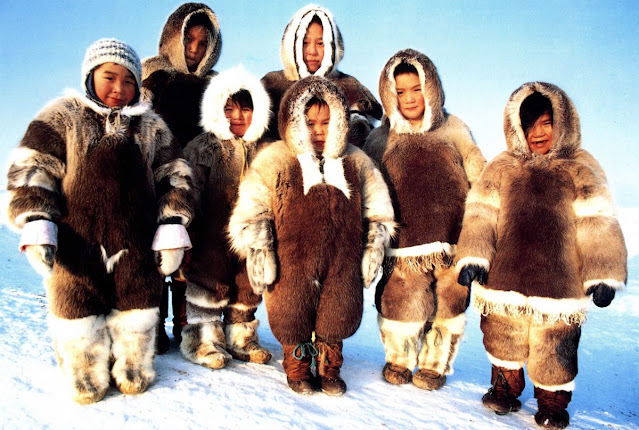The Arctic Peoples: Explaining the Anomaly in Richard Lynn's Cold Winters Theory of the Evolution of Intelligence
In a way this is a re-post from the old BRI/4R days, but here it is.
Cold Winters Theory
According to the Cold Winters Theory of the evolution of human intelligence of the races, those people who evolved over the millennia in colder climates, tended to get selected for higher IQs, and thus some races evolved to be more intelligent than others. Living in a colder climate presents many more challenges than living in a Savannah-like, tropical, and sub-tropical environments. In addition to scarcity of the food, the populations have to deal with the cold, and keep themselves warm.
In colder environments it was necessary to hunt dangerous big game animals in groups and generally collaborate within a unit for this purpose. It is more possible to just pick berries, other fruits, or take eggs in a warmer environment. The tools in use by hunter gatherers in colder environments tend to be more complex than in warmer climates. In colder environments food must also be provisioned for the cold winter when it gets cold, and clothing and shelter must be in place. This requires forward planning.
In addition to selecting for intelligence the cold weather tends to select human populations for the personality trait of conscientiousness. This reduces intra-species competition and encourages co-cooperativeness and law-abidingness.
Overall races that evolved in colder climates, such as Northeast Asians (105) and Europeans (100), tend to be more intelligent than races that evolved in warmer climates such as North Africans and South Asians (84), Southeast Asians (87) and sub-Saharan Africans (70), however the Arctic peoples who include the Inuit, which were also called Eskimos, who inhabit the Northern reaches of Canada, and Alaska, and are also native inhabitants of Northern Siberia, only have an average IQ of about 91. They are identified as a distinctive genetic “cluster” by Cavalli-Sforza, Menozzi, and Piazza (1994) in their classification of peoples based on a number of genetic markers. This is in spite of the fact that they evolved in environments which had the lowest average winter temperature.
The Intelligence of the Arctic Peoples
Although the average intelligence of the Arctic Peoples is only 91 and thus lower than Europeans, and Northeast Asians, they do have a higher average intelligence than the race that is closest related to them, the Amerindians, which have an average of about 87. This does show that the cold winters did indeed select them for higher intelligence. It should also be noted that the Arctic people also have a much more Mongoloid appearance, with brachycephalic (round shaped) skulls, and more epicanthic eyefolds (another cold adaptation). Still this presents an anomaly to the cold winters theory, and in science when you have an anomaly you either alter your basic assumptions of the theory or discard it for a better one. But what else could explain average intelligence in a population?
Richard Lynn asserts that there must be another factor in the evolution of intelligence for a population and that it is most likely population size. Larger populations tend to have more mutations and more mutations that can spread throughout it.
It is difficult to estimate ancient populations but historically it is clear that the population of Europeans and Northeast Asians is and most likely was quite high, whereas for the Arctic people in the mid twentieth century it was around 50,000, which is very small in comparison to the 1.4 billion Northeast Asians.
Visual Memory and Average Brain Size
On the other hand the Arctic people have a very good visual memory, and in many studies it has been shown that they have superior visual memory abilities to that of Europeans. This is hypothesized to have evolved to help them navigate through areas with few visual markers.
Their brain size is on average larger than that of Europeans and is on par with Northeast Asians, brain size is correlated with intelligence but is not the sole correlate. Thus either more of their brains are devoted to visual memory, or they simply hadn't received the mutations for the neurophysiological processes for higher intelligence that the Northeast Asians had.
Conclusion
Hence for human populations evolving in a colder environment is a contributing factor of higher average intelligence, as is population size.
Reference: Lynn, Richard. Race Differences in Intelligence: An Evolutionary Analysis Washington Summit Publishers. Kindle Edition.


Comments
Post a Comment